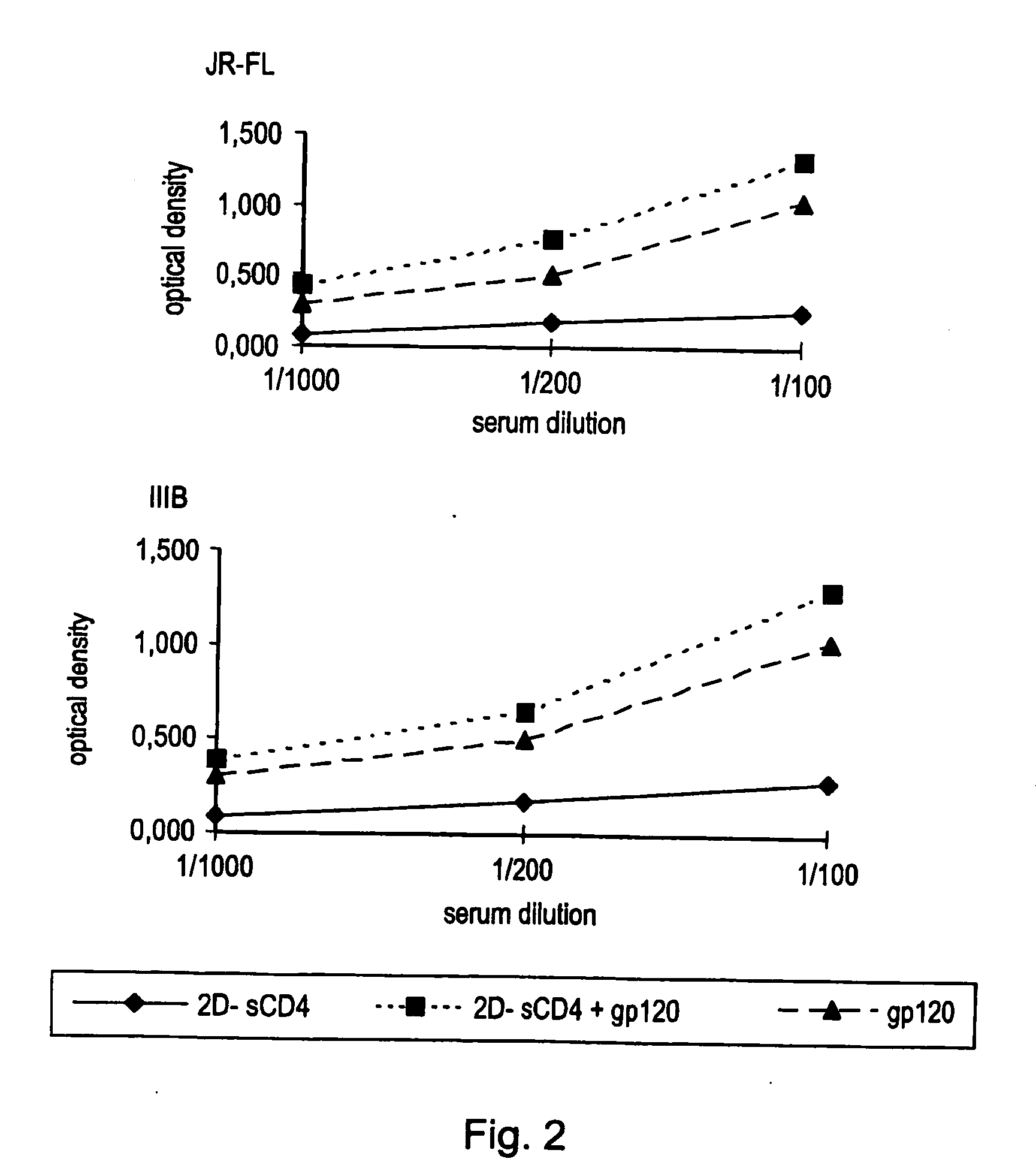Pharmaceutical compositions comprising an hiv envelope protein and cd4
a technology of cd4 and composition, which is applied in the field of pharmaceutical compositions and fixed cells, can solve the problems of extraordinary challenges, inability to generate anti-hiv-1 vaccines based on purified, soluble forms of gp120, and inability to effectively prevent hiv infection
- Summary
- Abstract
- Description
- Claims
- Application Information
AI Technical Summary
Benefits of technology
Problems solved by technology
Method used
Image
Examples
example 1
Preparation of Fixed Cells
[0199] NIH-3T3 cells were infected with a vaccinia vector expressing the HIV-1 BaL envelope (vCB43), then treated with 2D-sCD4 and fixed with glutaraldehyde. The fixation was done by incubating cells (previously reacted with 1 μg soluble CD4 per million cell), at a 2×106 cells per ml concentration with glutaraldehyde 0,5%, for 10 min at 20° C. Glutaraldehyde was prepared from grade I aqueous solution 25% (Sigma G5882) and diluted with phosphate buffered saline (PBS) up to final concentration. Cells were then washed 3 times with 10 ml ice cold PBS (1,500 RPM per 5 min each time) and brought in PBS to a concentration suitable for injecting the immunogen (500,000 cells per mouse per injection in 250 μl injection volume).
example 2
Generation of Serum IgG Which Preferentially Recognises gp120-sCD4 Complex
[0200] Serum IgG obtained from mice injected subcutaneously with cells expressing a complex of gp120 and sCD4 on their surface preferentially recognize gp120 when complexed with sCD4, as shown by cytofluorimetric analysis (FIG. 1). Pooled sera from 4 mice immunized with NIH-3T3 cells infected with a vaccinia vector expressing the HIV-1 BaL envelope (vCB43), then treated with 2D-sCD4 and fixed with glutaraldehyde were used.
[0201] As a target for cytofluorimetric analysis uninfected (panel A) or vCB43-infected (panel B) NIH-3T3 cells were used. Solid lines represent the background fluorescence profile (cells reacted with FITC-conjugated, goat-anti-mouse IgG polyclonal antibody). Binding to cells treated (dotted line) or not (dashed line) with 2D-sCD4 are shown. The cells were analysed on a FACScan analyser.
example 3
Generation of Serum IgG Which Preferentially Recognises Solid Phase Recombinant HIV-1 gp120 Solid Phase Antigen
[0202] Serum IgG obtained from mice injected subcutaneously with cells expressing a complex of gp120 and sCD4 on their surface preferentially react with gp120 / sCD4 complexes, as shown by ELISA assay (FIG. 2). Pooled sera from 4 injected subcutaneously with NIH-3T3 cells infected with a vaccinia vector expressing the HIV-1 BaL envelope (vCB43), treated with 2D-sCD4 and fixed with glutaraldehyde were used. The solid phase antigen was recombinant HIV-1 gp120 from a prototypic R5 isolate (JR-FL) or from a prototypic X4 isolate (IIIB), used either alone or in combination with 2D-sCD4. The ELISA assay was performed using standard protocols.
PUM
| Property | Measurement | Unit |
|---|---|---|
| concentration | aaaaa | aaaaa |
| concentration | aaaaa | aaaaa |
| concentration | aaaaa | aaaaa |
Abstract
Description
Claims
Application Information
 Login to View More
Login to View More - R&D
- Intellectual Property
- Life Sciences
- Materials
- Tech Scout
- Unparalleled Data Quality
- Higher Quality Content
- 60% Fewer Hallucinations
Browse by: Latest US Patents, China's latest patents, Technical Efficacy Thesaurus, Application Domain, Technology Topic, Popular Technical Reports.
© 2025 PatSnap. All rights reserved.Legal|Privacy policy|Modern Slavery Act Transparency Statement|Sitemap|About US| Contact US: help@patsnap.com



